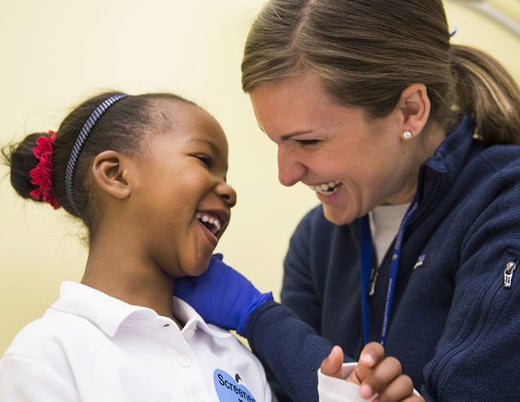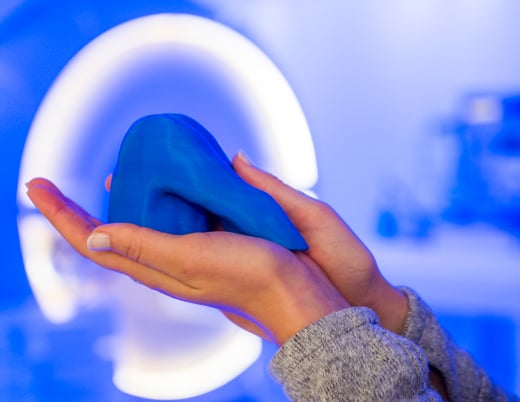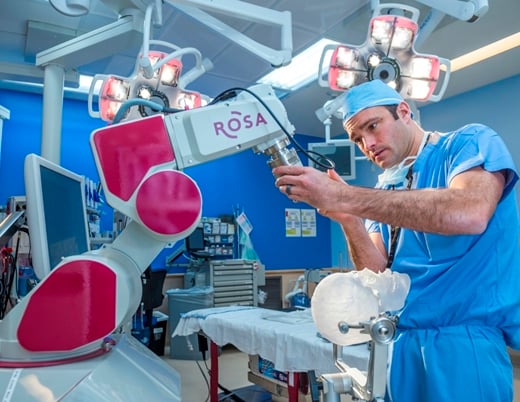How are treatment options improving outcomes and quality of life for kids with craniopharyngioma?
Craniopharyngioma, a rare, benign brain tumor that primarily appears in children ages 5 to 14, is historically an understudied area in neuro-oncology research. Although craniopharyngiomas typically have good outcomes regarding tumor control, they grow near vital brain structures, including the optic nerves, pituitary gland and hypothalamus. This often results in debilitating symptoms, ranging from vision impairment to hormonal imbalance, to significant difficulties with weight control. These symptoms significantly affect quality of life and make standard treatments complex. But now, thanks to a decade of work by Todd Hankinson, MD, a pediatric neurosurgeon at the Children’s Hospital Colorado Neuroscience Institute, promising therapies are emerging.
Challenges of craniopharyngioma research
Historically, craniopharyngioma is known for being a complex tumor to study, due to its hypothalamus-pituitary location in the brain, composition (solid mass and cystic component) and rarity (5% to 10% of all pediatric brain tumors).
“It’s a relatively uncommon condition, meaning most places don’t see enough cases to study tissue or patient outcomes effectively,” Dr. Hankinson says. “The tumor’s unique structures, featuring both solid and cystic parts, also behave differently, making it challenging to grow in culture.”
Despite research and funding limitations, Dr. Hankinson recognized the understudied nature of craniopharyngioma and spearheaded the creation of the first North American multicenter consortium dedicated to exploring novel treatments, known as Advancing Treatment for Pediatric Craniopharyngioma. Funded by The Morgan Adams Foundation Pediatric Tumor Research Program, the consortium started with analyzing existing craniopharyngioma data, later broadening its scope to include quality of life assessments and detailed clinical data collection. This allowed the group to work together to gather tissue samples for foundational research. Since the consortium’s creation, Dr. Hankinson has emerged as a leading expert in the field, having authored numerous studies and trials with novel therapies, such as those targeting the MAPK and IL-6 signaling pathways.
Complexities of craniopharyngioma treatment
Typical craniopharyngioma treatment usually begins with surgery. Depending on the amount of tumor removed and the other effects of the tumor, this is followed by complementary treatments (e.g., radiation, chemotherapy and hormone replacement therapy), which are individualized to maintain the highest possible quality of life. Despite being a benign tumor with a high survival rate, craniopharyngioma patients report significantly lower quality of life scores than any other pediatric brain tumor.
Tumors located in the sellar region of the brain sometimes compress the pituitary gland and stalk, which are essential for hormone production. This compression may result in stunted growth, delayed puberty and excessive urination and thirst. Other manifestations of craniopharyngioma include compression of the optic chiasm/optic nerves and hypothalamus, which can cause vision impairment, weight gain, fatigue, and sleep and memory problems. Tumors higher up in the suprasellar space can also obstruct the third ventricle, leading to a buildup of cerebrospinal fluid that causes headaches, nausea, vomiting, confusion and drowsiness.
The pursuit of maintaining a patient’s quality of life is heavily influenced by several key factors, including avoiding injuries to the hypothalamus and endocrine system, as well as vision loss. These complications can critically disrupt a child’s capacity to navigate everyday life. Fertility issues may also come to the forefront, potentially impacting future family planning.
“The various presentations of craniopharyngioma that we see add a layer of complexity to treatment,” Dr. Hankinson explains. “For example, if there’s concern about injuring the hypothalamus, the preference leans toward a more conservative surgery, followed by individualized therapies.”
Endocrine injuries further complicate matters, necessitating hormone replacement therapy. This involves administering various medications, such as growth hormone, thyroid hormone and steroids, particularly during periods of illness. The burden of adhering to such complex therapeutic regimes can add strain to patients, further impacting their quality of life.
In pursuit of novel craniopharyngioma therapies
Although first-line treatments have been refined over the years, 20% to 40% of tumors end up recurring. It’s at this point that novel therapies are usually considered, but Dr. Hankinson hopes to see that change.
“The ultimate goal is to make these novel treatments the primary therapy if they prove effective,” he says.
Dr. Hankinson is the co-principal investigator for two clinical trials currently in phase 2: one investigating the use of binimetinib, a MEK1 and MEK2 inhibitor, and another exploring the use of tocilizumab, an IL-6 receptor antagonist. A third trial, led by the Pacific Pediatric Neuro- Oncology Consortium, involves an immunotherapy drug called nivolumab, which is used in combination with tovorafenib, a pan-RAF inhibitor similar to an MEK inhibitor. Despite administrative challenges and regulatory hurdles, Dr. Hankinson is optimistic about the trials’ progression and the potential for improved craniopharyngioma therapies. These trials, which are international in scope, are anticipated to remain open for a couple of years, and researchers are holding regular meetings with pharmaceutical companies to ensure progress and drug availability.
“Despite the challenges,” Dr. Hankinson says, “we are making significant strides toward improving treatment and quality of life for children affected by this complex, and sometimes perplexing, condition.”
Featured Researchers

Todd Hankinson, MD
Division Head
Pediatric Neurosurgery
Children's Hospital Colorado
Professor of Neurosurgery and Pediatrics
University of Colorado School of Medicine





 720-777-0123
720-777-0123










